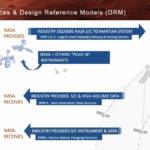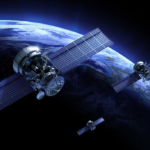WASHINGTON — Startup Portal Space Systems, founded by a former SpaceX and Amazon executive, has unveiled plans for spacecraft that use a novel propulsion technology designed to enable rapid movement between orbits.
The company formally exited stealth mode April 30, announcing that it had secured more than $3 million in awards from the Defense Department. That funding, as well as separate, undisclosed private investment, will support development of a spacecraft bus called Supernova.
What distinguishes Supernova is its solar thermal propulsion system, which uses solar energy to heat a propellant and generate thrust. Portal says that system can provide a delta-V, or change in velocity, of six kilometers per second with high thrust, enabling the spacecraft to move from low Earth orbit to geostationary orbit in a matter of hours, or from LEO to cislunar space in days.
“I saw the need for mobility solutions that didn’t exist for both commercial and military applications,” said Jeff Thornburg, chief executive and founder of Portal, in an interview. He cited the military’s interest in particular in dynamic space operations and “maneuver without regret,” or the ability to move spacecraft as needed without worrying about reducing its lifetime.
Thornburg founded Portal Space Systems in 2021 with Ian Vorbach, the company’s chief operating officer, and Prashaanth Ravindran, vice president of engineering, after working as head of mechanical engineering and manufacturing for Amazon’s Project Kuiper broadband constellation. Earlier in his career he was senior director of propulsion at SpaceX, serving as architect of the Raptor engine used on the Starship vehicle.
He said the company spent the first two and a half years talking with prospective commercial and national security customers to better understand their needs. “I’m a firm believer that the number one problem with small space businesses now is that they break away from other places or companies and they want to go do cool stuff, but they don’t think about the fact that they need a customer,” he said.
That customer discovery process led Portal to design Supernova. “It’s a high delta-V capable machine that really addresses both commercial and military mobility needs on orbit right now,” he said. That includes, for commercial customers, increased maneuverability in LEO for collision avoidance and to move spacecraft quickly from LEO to GEO, as well as various needs for maneuverability for military customers.
Thornburg said he had earlier been interested in nuclear thermal propulsion, but cost and regulatory challenges led him to instead pursue solar thermal propulsion. “We innovated around solar thermal because of its simplicity and its reliability,” he said, building on work done by NASA and the Air Force in the 1990s and early 2000s but making use of new technologies like additively manufactured components using new alloys. “It allows us to be successful at the right price point for a technology like this.”
He declined to disclose the propellant that would be used by the propulsion system, but described it as a storable propellant that has previously been used in spacecraft. “It stores well and packs a lot of delta-V for Supernova.”
While the company bills Supernova as a spacecraft bus, it also serves roles like a tug. “We don’t call ourselves a tug because we’re really servicing multiple different mission sets that include refueling and space situational awareness,” he said. “We can put people’s payloads on our front end and take them to orbits they can’t achieve with the traditional propulsion systems and bus structures that exist right now.”
He emphasized the ability of Supernova to serve a variety of different applications. “I didn’t want to leave any money on the table and there’s a lot of people that need delta V, but not necessarily for the same thing,” he said.
The company currently has 25 employees and is moving into a new facility in the Seattle suburbs. The first Supernova is scheduled to launch in late 2025 on a demonstration mission.
If that is successful, Thornburg said Portal will quickly scale up production of the spacecraft. “I want us to be ready to start producing these things upon successful demonstration,” he said, citing anticipated demand. That production will start at one spacecraft a month but could scale up from there. “I’m pretty confident based on the customer interest that once the demonstration flight occurs, we’ll probably have to reset and talk about that.”
Related
Author Profile
- Space.com is an online publication focused on space exploration, astronomy, skywatching and entertainment, with editorial teams based in the United States and United Kingdom
Latest entries
 ScienceMay 12, 2024National Space Council will explore military space and intelligence roles and responsibilities
ScienceMay 12, 2024National Space Council will explore military space and intelligence roles and responsibilities ScienceMay 5, 2024NASA awards studies for commercial Mars missions
ScienceMay 5, 2024NASA awards studies for commercial Mars missions ScienceMay 4, 2024Air Force project blends military and commercial space networks
ScienceMay 4, 2024Air Force project blends military and commercial space networks ScienceMay 4, 2024Nelson lobbies Congress to fund ISS deorbit vehicle in supplemental spending bill
ScienceMay 4, 2024Nelson lobbies Congress to fund ISS deorbit vehicle in supplemental spending bill

